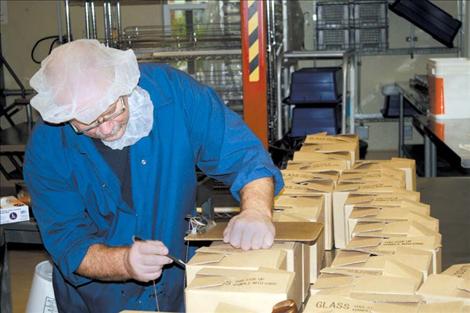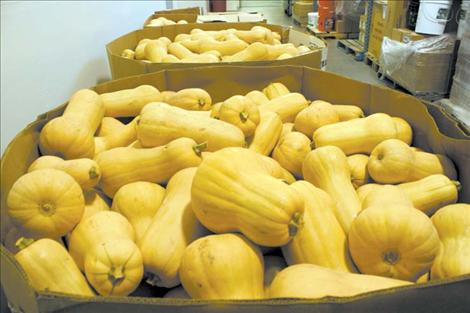Farm-to-School initiatives inspire health, excitement
Hey savvy news reader! Thanks for choosing local.
You are now reading
1 of 3 free articles.
RONAN — Farm-to-school initiatives are programs and efforts designed to connect schools with local food producers. In addition to boosting the local economy, these programs help to educate students and teachers on the importance of healthy food choices, the process of agriculture and ranching and, very simply, knowing where their food comes from.
Mission Mountain Food Enterprises Center is a division of Lake County Community Development in Ronan. Recently, MMFE began its own farm-to-school initiatives in an effort to bring farmers, children, parents and educators together under one roof.
For the past two years, the focus has been on getting more local foods into school cafeterias. MMFE is an ideal place to begin this process, as it has a food-processing center in-house.
“Often, the barrier for schools using local foods is that using whole foods takes more time to prepare it,” said FoodCorps Service Member Nicki Jimenez. “MMFEC can remove that barrier because they can process them and send them to the school chopped up and ready to use.”
Jimenez said there are a lot of people throughout the state with the same job as her, but they don’t have the processing step in between producers and the schools.
“You can always get local foods, but it usually takes an extra step, which is hard,” she said.
Utilizing this in between step, the Western Montana Growers Co-op is able to aggregate and distribute locally grown, fresh food. This allows MMFE to source to schools on the scale necessary to make the entire process a success.
As October is Farm to School month, MMFE is celebrating with a wide array of events at local schools.
Last week, both Ronan and Polson schools had Montana-made meals served in all the K-12 schools. Ronan alone used 100 pounds of local beef, 120 pounds of local apples and 60 pounds of carrots. Each student was served a cup of locally produced taco soup with apples and carrots for lunch.
Polson also had Montana-made meals consisting of locally grown and produced beef, onions, egg noodles, carrots and apples resulting in a beef stroganoff.
To further solidify the connection between farmers and the food we eat, K. William Harvey Elementary school in Ronan held a drawing where kids got the opportunity to eat lunch with a farmer. The event was so successful that some people were actually sneaking into the cafeteria.
“People were really excited the farmer was the special guest in the cafeteria,” Jimenez said. “It was pretty exciting.”
Driving home the reason for the event, Jimenez asked one of the children what his favorite vegetable was. The child responded, “A fruit.” Many didn’t know that beef came from cows.
“This was a great way to generate excitement about local foods and farmers,” Jimenez said.
The long-term goal, according to AmeriCorps VISTA member Shay Boudreau, is to sustain farm to school efforts throughout the year and to work as a community to continue to get fresh fruits and vegetables onto student’s plates while educating them about their food.
At K. William Harvey Elementary, art teacher Barnaby Smith is working with MMFE on a Farm-to-School art project creating pictures with beat juice. MMFE is also working with teachers to add in-classroom demonstrations designed to teach kids why eating local and eating vegetables is healthy both for their bodies and for the local economy.
“It’s really important to know where your food comes from, because that helps make the connection that food doesn’t come from the grocery store or a package,” Boudreau said. “Real food is grown on a farm.”
Boudreau is currently working with Salish Kootenai College to garner support from students and the extension office to involve the newly constructed greenhouse on SKC’s campus in food sovereignty initiatives. Boudreau cited the lack of healthy food options surrounding SKC’s campus as a powerful motivator for promoting healthy, affordable and sustainable foods on-campus.
Boudreau will host an event Oct. 24 from 11:30 a.m. to 1:30 p.m. in the Camas Room at SKC to educate students, begin a discussion and generate interest. Boudreau cited three major reasons why people should care about their food and where it comes from.
Economic impact: Buying local foods and supporting local farmers helps the local community and economy.
Environmental mpact: Most of the food consumers buy at a grocery store travels an average of 1,500 miles. The environmental savings from halting the need to transport food over such distances would be immense.
Health impact: Locally sourced foods travel less than 50 miles. This allows fruits and vegetables to stay on the vine longer and increases the amount of nutrients in the food.
“I think one of the biggest topics in the news is obesity and how much it’s going to cost in the future,” Boudreau said. “Preventing childhood obesity is one of our biggest goals in these grassroots organizations. If we can put them on a healthy track now, then we’ll have them there for the rest of their lives.”
“I think the huge thing is also economic development,” Jimenez added. “There’s all this talk about everything in the economy and the elections, but we’re really doing stuff down here to help local farmers and local businesses.”
Both women expressed the need to involve the community in continuing efforts to forward farm-to-school initiatives.
“We can’t do it all by ourselves,” Jimenez said. “It’s definitely a true community effort, and that’s one of the reasons these organizations put us here.”

















